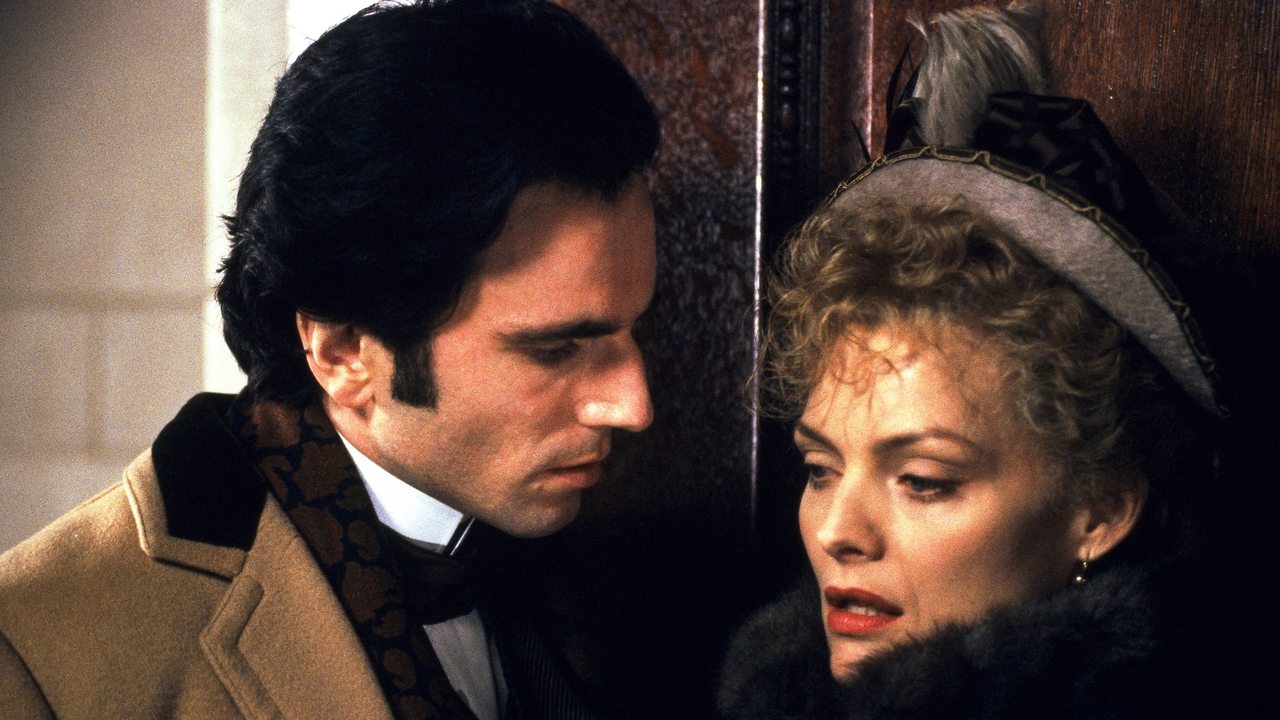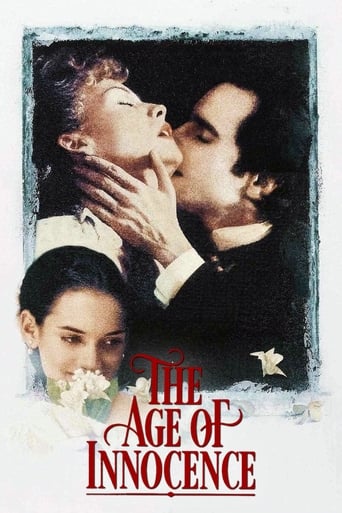

You may have to shrug off your disdain for films about the upper crust of society to watch this one. If you can do that, and if you can patiently allow the story to unfold, you will be rewarded. Director Martin Scorsese is true to Wharton's brilliant novel, and was painstaking in his attention to all of the little details of the time period. The narration by Joanne Woodward is excellent. The forbidden love Newland Archer (Daniel Day-Lewis) has for Countess Olenska (Michelle Pfeiffer) while being engaged to May Welland (Winona Ryder) grows ever so gradually, until it becomes a raging fire. At the same time, there is great restraint here, accurate to the morals of the day, but leaving one with a much deeper feeling of the angst involved as a result. The little signals each person in this love triangle send to one another often have great subtlety, yet it feels just as powerful as if they were yelling or screaming.I confess I didn't think any of the three principal actors delivered a great performance – Day-Lewis is a little too morose, Pfeiffer lacks that teeny touch of wickedness, and Ryder's acting is the most suspect, despite her Oscar nomination. The chemistry between Day-Lewis and Pfeiffer does not seem authentic, but with all of that said, each of them is reasonably good. I think Scorsese was dead on with the tone and this is clearly a labor of love, but I don't think the story needed 139 minutes, and there are some issues with pace (which compound the understated action). On the other hand, he gives us some truly wonderful moments, all leading to an ending that is absolutely brilliant, which, just as with the novel, left me with goosebumps.
... View MoreDaniel Day-Lewis is Newland Archer, the protagonist of Edith Wharton's novel about love, manners, ethics, money, gossip, and inner turmoil in upper-class 19th-century New York in the 1870s. Day-Lewis recently announced his retirement from acting and it's a damned shame. His Newland Archer is slow-spoken and delicate in his movements. Very polite, you know, kissing hands, attending the opera, and the like. But his Bill "Butcher" Cutting was a convincing brutal, coarse murderer in "Street Gangs of NewYork," a rabid and ultimately psychotic capitalist in "There Will Be Blood," and an action hero in "Last of the Mohawks." I can't tell if he's particularly handsome or not but his features are plastic enough to fit these varied roles with credibility, as do his performances.The set dressing, the art department, and the production design have outdone themselves in providing period appointments. The screen is filled with evening clothes, hansom cabs, ferns, and piles of flowers -- -- the "Gilded Age" for those fortunate enough to have been gilded. It was quite an age. No income tax, entrepreneurs and racketeers rich beyond belief. Diamond Jim Brady lighting his cigars with dollar bills while eleven-year-old kids worked diligently in the coal mines to provide those dollar bills. Director Scorcese amalgamates all these elements into a visual narrative that -- while pretty dull -- is identifiably Scorsese's own. Overhead shots of swarming crowds or significant objects, cross cutting between a decorous love scene in a horse-drawn carriage and high shots of the carriage wheel turning and leaving dirt tracks in the powdery white snow. Day-Lewis in his parlor received some devastating news from his wife, Winona Ryder, and though he shows no excitement, there is a brief cut to a burning log in the fireplace breaking and crumbling with a subdued plop.I said it was "pretty dull" and meant it. I could barely keep up with the many characters and the relationship between them, both the obvious ones and those sub rosa. I confess to a few periods of microsleep. Watching all the scenes of opulence made me feel small and broke. Especially one scene at a very long dinner table with overhead shots of the exquisite food the elaborately groomed guests are dining on. I'm sure I would have used the wrong fork. And in an attempt to overcome my nervousness I might have called for more wine and wound up half drunk, with the others all watching me out of the corners of their eyes, far too politic to ever remark about my behavior.I have none of the aplomb of Herb Mankiewicz who was invited to dine with William Randolph Hearst at his elegant mansion. Hearst allowed no alcohol but his girl friend sneaked some to the guests. Herb managed to throw up after the first course but recovered nicely, dabbing at his lips with a white napkin and assuring Hearst, "Don't worry, Bill, the white wine came up with the fish." Good luck with the movie. You have never seen so much emotional restraint.
... View MoreIt's the 1870's in NYC. Newland Archer (Daniel Day Lewis) is to be married to the innocent May Welland (Winona Ryder). May's cousin Countess Ellen Olenska (Michelle Pfeiffer) has come to stay. The Countess married poorly to a Polish count who took all of her money. She left him and is the subject of gossip in the proper world. Despite this, May and her family supports her and so does Newland now. The Archers are much more traditional and Newland is expected to marry well for the family. Newland falls for Ellen who decides to divorce her abusive husband. More and more, he finds the naive May to be an empty dress.It seems that Martin Scorsese is more in love with this world and trying to explain it rather than tell a compelling story. The narration plays up the literary background of the material but it is just as stuffy as the world it purports to skewer. Joanne Woodward makes it almost an old fashion MasterPiece Theater. Scorsese is a master filmmaker and this is a beautiful film. The sets are gorgeous. However the narration just droned on and on and on. It is all so boring with every exposition of the various passive aggressiveness.
... View MoreIn the early nineties Martin Scorsese's reputation was largely that of a maker of tough, gritty and violent films about the underworld or modern-day urban street life, often with a maladjusted, anti-social loner at their heart. He had, admittedly, made occasional films on other subjects, notably "The Last Temptation of Christ", but even so he was not the most likely candidate to direct an adaptation, in best Merchant-Ivory "heritage cinema" style, of a novel by Edith Wharton. "The Age of Innocence" was to reveal him as a more versatile director than many had hitherto realised. "Heritage cinema" is often regarded as something uniquely British, although this is a misconception; there are, for example, a number of fine French examples. A number of Americans have played a part in the development of the genre in Britain; James Ivory is American by birth, as was Joseph Losey who directed one of the earliest examples of the style, "The Go-Between". "The House of Mirth" (also based on a Wharton novel) is a film in this style on an American subject, but made in Britain by a British director, Terence Davis. "The Age of Innocence", by contrast, is a piece of genuinely American heritage cinema, although several of the cast are British or Irish. The story is set among the affluent classes of 1870s New York. Newland Archer is a lawyer engaged to be married to the beautiful young socialite May Welland but who finds himself attracted to May's cousin, Countess Ellen Olenska. Ellen is something of a controversial figure in New York's high society. She is separated from her abusive and unfaithful husband, a Polish count. Worse still, rumour has it that she herself has had an adulterous affair with her husband's (male) secretary. Newland first meets Ellen when she consults his firm about a possible divorce, although she eventually decides not to go through with it in order to spare her family further scandal. (Although American law at this period permitted divorce, American high society strongly disapproved of it). As their friendship deepens into love, Newland has to decide whether to follow the desires of his heart or the expectations of society. When I first saw this film in the cinema, back in 1993, I remember thinking that Newland must be mad if he could contemplate leaving the lovely Winona Ryder, with her fragile, haunting beauty, even for someone as undoubtedly attractive as Michelle Pfeiffer. I must say that my wife is still of that opinion, but having seen the film again recently I began to understand his feelings more. Ryder's May, for all her loveliness, is someone who comes across as shallow, conventional and slightly dull. Pfeiffer's Ellen, by contrast, is a woman of greater maturity, experience and worldly wisdom. Her air of exoticism and sophistication might make her suspect in the eyes of society, but it is precisely these characteristics which make her so fascinating to Newland. Newland is not what I have come to think of as a typical Daniel Day-Lewis character. Perhaps there is no such thing as a "typical Day-Lewis character", but the roles I most associate him with are those where he has to play individuals who are angry, outspoken or in some respect social outsiders. In some cases these figures are excluded from society by causes beyond their control, such as Christy Brown in "My Left Foot", excluded by his disabilities, or Gerry Conlan in "In the Name of the Father", excluded by an unjust conviction for a crime he did not commit, or Hawkeye in "The Last of the Mohicans", who feels more at home in Indian society than in the white society to which he belongs by birth. In other cases, however, he plays characters who can be considered anti-social personalities, such as Bill the Butcher in "Gangs of New York" (also made by Scorsese) and Plainview in "There Will Be Blood". In this film, however, Day-Lewis shows his versatility by playing a man who is very much a social insider, one who is fascinated by social outsiders like Ellen but who fears becoming an outsider himself. There is, in fact, some very subtle acting from all three of the leads. Pfeiffer also showed her versatility; her two previous roles before this one, Catwoman in "Batman" and the blue-collar housewife Lurene in "Love Field" had been about as different from Countess Olenska as one could imagine, although she had earlier played another period-drama heroine in "Dangerous Liaisons". The film's only acting Oscar nomination, however, went to Ryder for "Best Supporting Actress", which I felt was appropriate. Although May is the quietest of the three main characters, she is very much at the heart of the drama. (The "innocence" of the novel's title surely refers to her). As the film develops we realise that she might, in fact, be less naive and superficial, and more strong and determined, than she initially seems, making her a surprisingly complex character, and all these complexities are inherent in Ryder's performance. Another good performance in a supporting role comes from Miriam Margolyes as May's formidable grandmother Mrs. MingottThe film is visually sumptuous with strong, bright colours, especially reds, pinks, yellows and greens, much in evidence. Again, these are qualities one would not automatically associate with Scorsese's earlier works, which were often visually dark. ("Raging Bull", for example, was largely shot in black-and-white). Since 1993, however, these qualities have been seen in some of his later works, especially his other period dramas "Gangs of New York" and "The Aviator". "The Age of Innocence" can be seen as a fine example of Scorsese's skills as a film-maker. It is not entirely typical of his work- there is less physical action than in many of his films- but it perhaps seems less untypical today than it did in 1993. 8/10
... View More